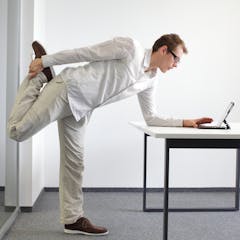
Articles sur Physical activity
Affichage de 141 à 160 de 199 articles

There has been a tenfold increase in the worldwide prevalence of childhood obesity over the past four decades.

If the menu of potential activities that do us good is made to look uninviting or challenging, we are more likely to choose the easier but less healthy option.

All Australians aged 13-17 are encouraged to do 60 minutes of physical activity a day.

Research indicates exercise is effective for improving mood and preventing the development of depression in young people.

Just what role does exercise play in weight loss? Plenty. While word has spread in recent years that physical activity isn’t all that important, a doctor debunks that myth.

We wear our surroundings like a cloak. Lower-income communities often live in environments that discourage healthy, outdoor activities. This perpetuates their poorer health and traps them in poverty.

A new study has found breaking old and forming new habits is key in keeping weight off.

Sport and other physical activity is vital to the developing bodies and minds of children; for those with disabilities it can be hard to access and is yet even more important.

The government’s new exercise campaign encourages us to get 30 minutes of physical activity a day. But while ads can get us to change our attitudes, they’re unlikely to change our behaviour.

Compulsory sport and physical education at school will improve children’s memory, attention and ability to concentrate, not just boost fitness. The evidence is in.

Why a bricklayer is more likely to die before a banker.

Four out of five experts say walking is enough exercise.

Policymakers need to stop focusing on schools to solve the obesity crisis.

Dropping old, bad habits is hard, but starting new, good ones may not be so difficult. Or so a recent study suggests. Read how a simple sign at an airport made a difference.

New data on soaring child obesity should not come as a surprise. The food industry spends billions marketing unhealthy foods in a global society where over-eating is seen as a character flaw.

Our ageing population presents several social and economic challenges, particularly for the health sector. Physical activity can tackle many of these.

Physical activity is considered an important way to lower risk for breast cancer. But what if your ability to be fit is influenced by genes you inherit? Would that raise your risk? In rats, it did.

If you sit all day at work, then cancer, diabetes, heart disease and death are the likely outcomes. A cardiologist explains how the simple act of counting can reverse this evolutionary trend.

Here’s how reporting of the world’s first specific advice on reducing inactivity at work has overplayed the role of standing desks.

The so-called ‘Mamils’ are looking for good mental health – not a chance to relive their youth.
